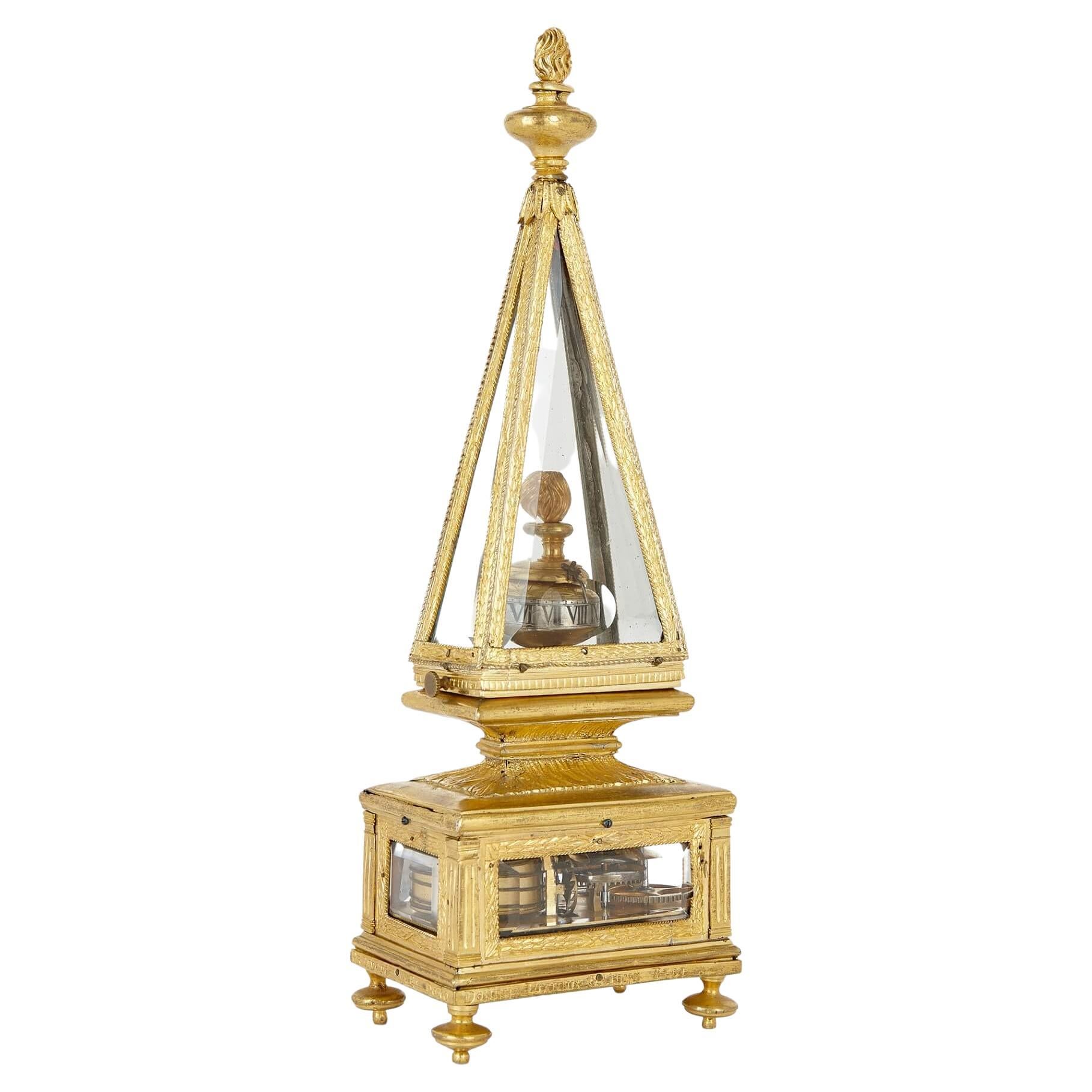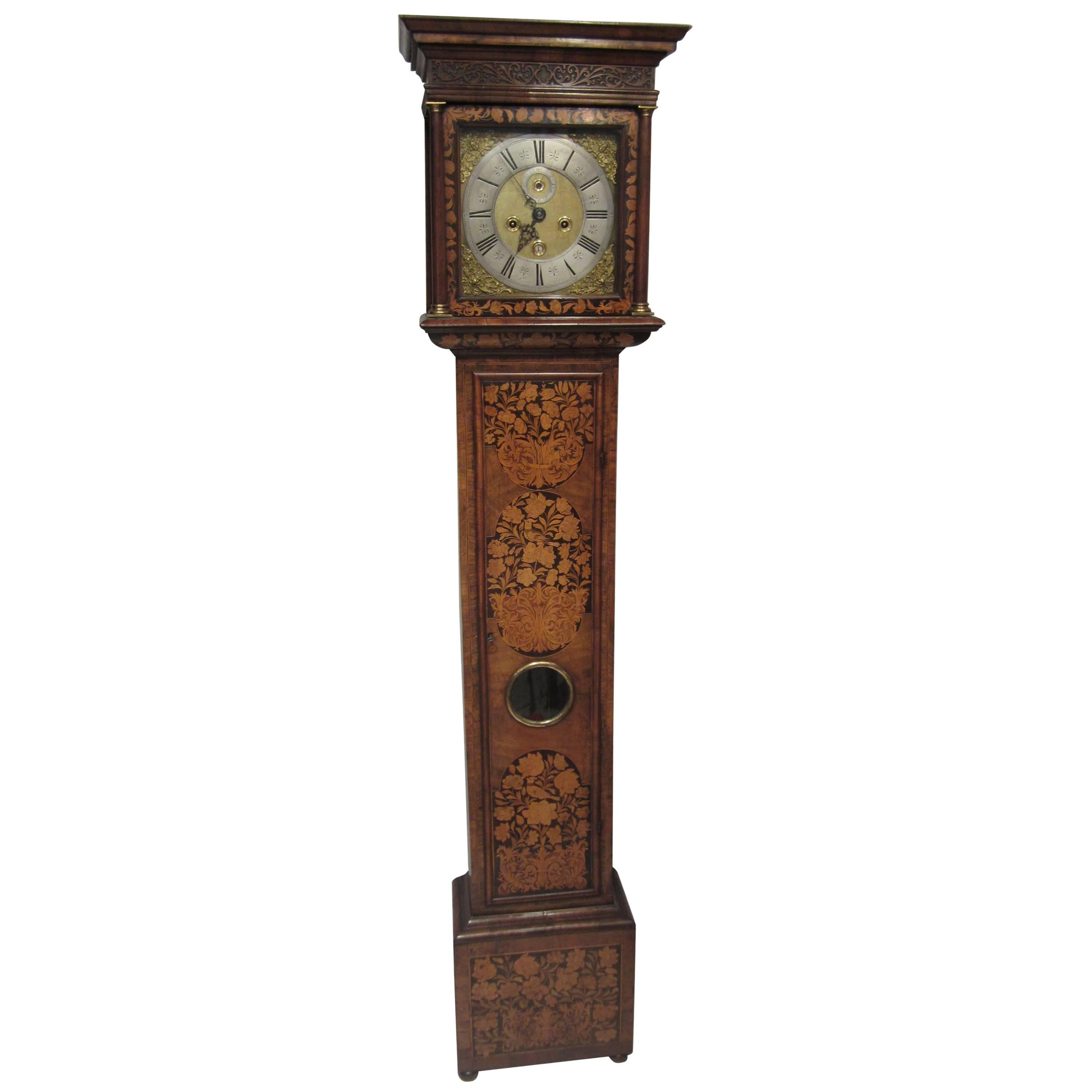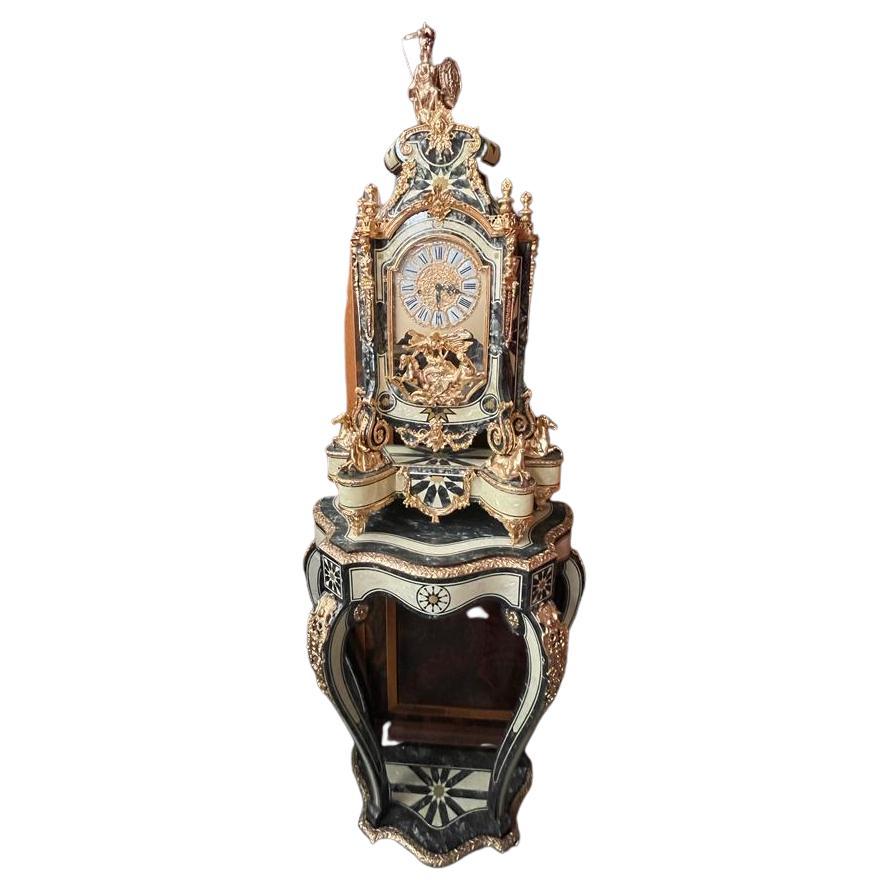Items Similar to 17th Century Hague Clock Signed by Pieter Visbagh, circa 1675
Want more images or videos?
Request additional images or videos from the seller
1 of 11
17th Century Hague Clock Signed by Pieter Visbagh, circa 1675
About the Item
Unusually small Hague clock made c. 1675 by Pieter Visbagh, who was apprenticed by Salomon Coster. The latter made the first pendulum clock according to the instructions of Christiaan Huygens, the internationally renowned scientist who developed the idea of applying a pendulum to a clock movement.
The delicate ebony-veneered case has a moulded broken arch pediment, whilst the door is flanked by plain half round Doric capital-capped columns on high bases. A traditional star adorns the internal face of the case surrounded by well-chosen cuts of olive in a parquetry fashion. This design of star was also popular in England around this time and was almost certainly introduce by the Huguenots.
The two-day movement is driven by a compact single barrel. The going train has its original verge escapement with a silk suspended pendulum between cycloidal cheeks, also a design by Huygens to improve the trajectory of the pendulum bob. The sides of the backcock are richly pierced and engraved. The striking train is regulated by an external pierced countwheel with a blued steel backing on the backplate to create a lovely contrast; the last hour struck is indicated by Arabic numerals. The striking, which has elaborately pierced striking gates, sounds the hours on a bell inside the case, which has a sound fret in the bottom. The backplate is signed at the bottom by the maker: Pieter Visbagh Fecit Haghe.
The velvet-covered brass dial is hinged on the left hand side, giving access to the movement, which has an almost bronze-like patina caused by age. It has a fine skeletonised gilt-brass Roman chaptering with half hour and Arabic minute divisions. The time is indicated by a fine pair of original gilt brass hands, the hour hand delicately pierced. Below is a shaped and chased signature cartouche, consisting of a crowned coat of arms held by two putti. It bears the maker’s name: P. Visbag Haghe. It is hinged at the top and upon lifting a rectangular hole is revealed through which the pendulum can be activated.
Dimensions: height 35 cm; width: 24 cm; depth: 13 cm
- Creator:A. Petersen & Co. (Clockmaker)
- Dimensions:Height: 13.78 in (35 cm)Width: 9.45 in (24 cm)Depth: 5.12 in (13 cm)
- Style:Baroque (Of the Period)
- Materials and Techniques:
- Place of Origin:
- Period:
- Date of Manufacture:1675
- Condition:Wear consistent with age and use.
- Seller Location:Oxfordshire, GB
- Reference Number:1stDibs: LU4936216414211
About the Seller
5.0
Recognized Seller
These prestigious sellers are industry leaders and represent the highest echelon for item quality and design.
1stDibs seller since 2019
20 sales on 1stDibs
Typical response time: 1 hour
Associations
LAPADA - The Association of Arts & Antiques Dealers
- ShippingRetrieving quote...Ships From: Oxfordshire, United Kingdom
- Return PolicyA return for this item may be initiated within 14 days of delivery.
More From This SellerView All
- 17th Century Lantern Alarm Clock by Johannes Quelch, OxfordLocated in Oxfordshire, United KingdomAn English 17th century lantern clock made of brass and iron, circa 1665-1670. The clock consists of going and striking trains, as well as a...Category
Antique 17th Century British Baroque Wall Clocks
MaterialsBrass
- A Rare and Important Charles II 17th Century Table Clock by Henry JonesBy Henry JonesLocated in Oxfordshire, United KingdomThe Rare and Important 17th Century Spring Driven Table Clock by the Celebrated Maker, Henry Jones. Provenance dating back to 1745. Owned by Captain Alexander Raitt A very rare an...Category
Antique 17th Century English Charles II Table Clocks and Desk Clocks
MaterialsBrass
- 17th Century Charles II Month Going Marquetry Longcase Clock by John WiseLocated in Oxfordshire, United KingdomA superb Charles II month duration floral marquetry longcase clock by the well-known maker John Wise, c. 1680-85. Measure: 10". The case is of the highest quality and decorated throughout in very attractive floral marquetry depicting spring flowers and birds showing a high level of sophistication with a glazed circular lenticle to the door. Similarly, the rising hood is decorated with blind frets around the top and surmounted by a shallow caddy decorated by five gilt wooden ball finials. It is flanked by prominent gilt brass-capped solid barley twist columns, with blind fretted panels to the sides. The month-going nicely finned and knopped five pillar movement has reversed going and striking trains, the striking train (on the right) being regulated by a small outside countwheel. The going train has anchor escapement and a seconds pendulum. The movement is fronted by a 10-inch brass dial with an unusual narrow silvered chapter ring, seconds ring and date aperture. It has elaborate cherub-head spandrels in the corners and is signed along the bottom John Wise Londini Fecit. The middle is finely matted, whilst the time is indicated by a fine pair of blued-steel hands, the hour hand richly pierced. The maker John Wise was born in Banbury shortly before 17 March 1624, the date of his baptism. He was the son of John and Ann Wise and a cousin of Joseph Knibb...Category
Antique 17th Century British Charles II Grandfather Clocks and Longcase ...
MaterialsBrass, Steel
- Rare 17th Century William and Mary 10 Inch Ebonised Longcase/Grandfather ClockLocated in Oxfordshire, United KingdomA rare, early English eight-day longcase clock signed on the chapter ring Aynsworth London, dating to the period c.1690-1700. The elegantly proportioned ebonised case, formerly wit...Category
Antique 17th Century English William and Mary Grandfather Clocks and Lon...
MaterialsFruitwood, Oak, Pine
- Rare 18th Century George II Musical Table Clock by Matthew King, circa 1735Located in Oxfordshire, United KingdomA rare George II musical table clock by Matthew King, circa 1735. This unusual eight-day spring-driven table clock was made by Matthew King, wh...Category
Antique 18th Century English George II Table Clocks and Desk Clocks
MaterialsSilver, Brass
- Magnificent 18th Century Striking Dutch Amsterdam Burl Walnut Longcase ClockLocated in Oxfordshire, United KingdomAn impressive Dutch longcase clock with a burr walnut veneered oak case, signed on the chapter ring Pieter Brandt Amsterdam, c. 1745-50. The hood ...Category
Antique Early 18th Century Dutch Baroque Grandfather Clocks and Longcase...
MaterialsWalnut, Burl
You May Also Like
- 17th Century Obelisk-Shaped Table ClockLocated in London, GB17th Century obelisk-shaped table clock Italian, 17th Century Height 28cm, width 9cm, depth 7cm A stunning piece from the 17th century, this table clock is a precious element of horological artistry and mechanical innovation. Encased in gilt and glass, the delicate clock is shaped akin to an obelisk, an intriguing symbol that lends a striking visual appeal. The foundation of the timepiece is a gilt brass and...Category
Antique 1660s Italian Baroque Table Clocks and Desk Clocks
MaterialsBrass, Ormolu
- 17th-Century English Lantern Clock by Ignatius HuggefordLocated in Hoddesdon, GB17th-century English , Lantern Clock, by the historically important London clock maker Ignatius Huggeford... It is worth highlighting that Ignatius Huggeford held the distinction of...Category
Antique 17th Century British Charles II Mantel Clocks
MaterialsBrass
- 17th Century Walnut and Marquetry Longcase ClockLocated in East Hampton, NYLate 17th century walnut and marquetry longcase clock. Marked "Windmills, London"Category
Antique 17th Century English Clocks
- 17th Century Regency Clock and Console TableLocated in Cantù, ITA clock and console table in the style of Louis XIV made by parisian cabinet maker Lessure who specilised in the reproduction of statues of horses. He ...Category
Antique 17th Century Italian Table Clocks and Desk Clocks
MaterialsBrass
- Tall Case Amsterdam Clock, Signed Pieter Verlaer, circa 1840-1860Located in Miami, FLTall case Amsterdam clock. Signed Pieter Verlaer, Dutch, circa 1840-1860. walnut and burled walnut. Clock has an amazing dial with three ships that mov...Category
Antique 19th Century Dutch Rococo Revival Clocks
MaterialsWalnut
- Cross-Shaped Chest Clock, Silver, 17th Century, it Presents RestorationsLocated in Madrid, ESCross-shaped chest clock. Silver. 17th century. It presents restorations. Portable clock in the shape of a cross with an openwork exterior showing Christian figurative scenes and the movement inside, a dial with a golden band with Roman numerals for the hours, a single needle and an engraved decoration around it, also with a religious theme; on the back, the back of the movement can be seen, with a delicate decoration, also openwork and based on plant motifs reminiscent of classicism, and a band on the case of the piece with simplified plant elements. Outside, we find ourselves on one side with Christ crucified, flanked by the Virgin Mary and Saint John, and the figures are surrounded by a delicate composition based on vegetable scrolls, with an angel's head at the foot of the piece. The other side shows the Resurrection of Jesus, with Christ emerging from the empty tomb...Category
Antique 17th Century European Baroque Collectible Jewelry
MaterialsMetal, Silver, Other





